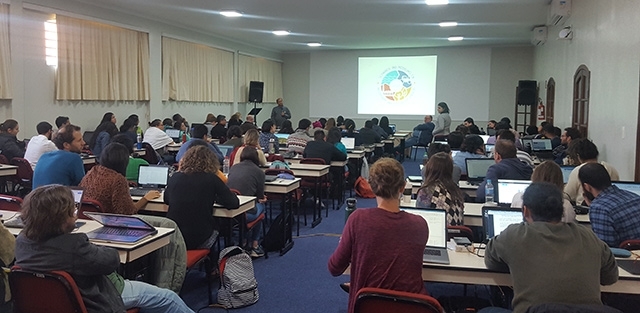


Young researchers were trained in environmental planning and protection at a School of Advanced Science supported by FAPESP (photo: Elton Alisson / Agência FAPESP)
Published on 05/12/2021
By Elton Alisson in São Pedro (Brazil) | Agência FAPESP – Growing environmental degradation and the extinction of animal and plant species at an unprecedented pace have increased the need for scenario building and modeling of biodiversity and ecosystem services such as pollination or water and food supply.
Scenarios and models are prospective analysis tools that are vitally important to environmental planning. They can be used to establish relationships among the environment, biodiversity and human activities. They can therefore help answer questions about the potential impact of political decisions on future biodiversity and ecosystem services and support the design and implementation of science-based restoration and conservation programs.
These conclusions were among those drawn by the researchers who participated in the São Paulo School of Advanced Science on Scenarios and Modeling Biodiversity and Ecosystem Services to Support Human Well-Being, held on July 1-14, 2019, in São Pedro, São Paulo State (Brazil).
The event was organized by the University of Campinas’s Biology Institute (IB-UNICAMP) in partnership with the Brazilian Platform on Biodiversity and Ecosystem Services (BPBES) and the Inter-American Institute for Global Change Research (IAI), with FAPESP’s support via its São Paulo School of Advanced Science (SPSAS) program.
The aim of the event was to enable graduate students to obtain advanced knowledge and practical experience in biodiversity and ecosystem service modeling and scenario development, especially as they relate to human well-being and public policy formulation.
“It’s crucial to train young researchers to use these tools and impart an understanding of the underlying conceptual and theoretical framework, which is at the forefront of research on conservation, restoration and the sustainable use of biodiversity and ecosystem services,” Carlos Joly, Full Professor at IB-UNICAMP and principal investigator for the School, told Agência FAPESP.
The event was attended by 87 doctoral students and postdoctoral researchers – 52 from Brazil (27 from São Paulo and 25 from eight other states) and 35 from 20 other countries.
The program for the event included lectures on theory, discussions of global and local scenarios and models, and practical coursework. Participants also analyzed nine case studies on subjects, such as the impact of urban expansion on the Atlantic Forest biome and impacts of human activities on coral reefs and mangroves in Puerto Morelos, Mexico.
“The analysis of the case studies began with biodiversity and ecosystem service metrics, and then, the monetary and nonmonetary value of each component was discussed. The next topic was on direct and indirect drivers affecting biodiversity and ecosystem services and their relative value. The participants then used tools to model the impact of conservation policies on these drivers,” said Joly, who coordinates the FAPESP Research Program on Biodiversity Characterization, Conservation, Restoration and Sustainable Use (BIOTA-FAPESP).
“At the end of the event, all information was compiled to create scenarios for a range of situations, such as business as usual, implementation of sound science-based conservation policies, and reversal of conservation policy.”
Most of the researchers from Brazil and from other countries who led the event contributed to the methodological assessment report on scenarios and models that was issued in 2016 by the UN Intergovernmental Science-Policy Platform on Biodiversity and Ecosystem Services (IPBES), often referred to as the “IPCC for biodiversity”.
The methodological report was the basis for IPBES’s assessment reports on pollination, land degradation and restoration, and it was the first global assessment of the state of nature, issued in May 2019 (read more at agencia.fapesp.br/30553).
“Together, models and scenarios can help describe or visualize plausible futures for the state of the environment and sound the alarm about the risk of biodiversity and ecosystem service losses,” said Karachepone Ninan, a researcher affiliated with the Institute for Social and Economic Change in Bangalore, India, in his presentation to the School.
“In this manner, it’s possible to make science-based decisions, assess a range of alternative public policy strategies and implement protective or reactive measures” said Ninan, who was Co-Chair of IPBES’s methodological assessment with Simon Ferrier, Senior Principal Research Scientist at Australia’s Commonwealth Scientific and Industrial Research Organization (CSIRO) in Canberra. Ferrier was also a lecturer at the School in São Pedro.
According to Ninan, the models most relevant to the kinds of assessments performed by IPBES address the effects of biodiversity and ecosystem service changes due to direct drivers such as climate change or land use, as well as indirect drivers such as economic, social and political factors.
Uncertainty due to data constraints, process representation and an ecosystem-scale resolution is a major challenge. “Uncertainty is associated with science,” he said. “Public policymakers must make decisions even amid uncertainty to further biodiversity and ecosystem service conservation.”
Participation by governments
In addition to graduate students from universities and research institutions in Brazil and abroad, the attendees also included researchers who work for government bodies such as IBGE, Brazil’s national census and statistics bureau, and the São Paulo State Departments of Agriculture and Infrastructure and Environment (SIMA).
“We’re now finalizing the São Paulo State Ecological and Economic Zoning Plan. One of the issues we address is the integration of biodiversity and ecosystem services. The School event coincided with this stage of the project, and I decided to participate to move ahead on this topic,” said Marco Aurélio Nalon, a geoprocessing researcher at SIMA’s Forest Institute.
The Ecological and Economic Zoning Plan (Portuguese-language acronym ZEE) is a legislative instrument that establishes urban and rural environmental standards; programs to protect biodiversity, water resources and soil quality; and measures to promote sustainable development. A national law requires every Brazilian state to develop a ZEE by 2020. SIMA is responsible for formulating São Paulo’s ZEE.
More information on the São Paulo School of Advanced Science on Scenarios and Modeling Biodiversity and Ecosystem Services to Support Human Well-Being can be found at scenariosbes.wixsite.com/spsas-scenarios.
Source: https://agencia.fapesp.br/31089